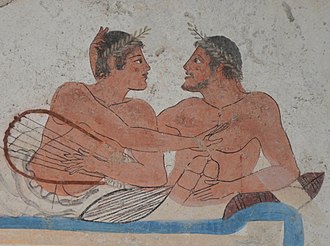
Pederasty in ancient Greece was a socially acknowledged relationship between an older male (the erastes) and a younger male (the eromenos) usually in his teens.[2] It was characteristic of the Archaic and Classical periods.[3]

Some scholars locate its origin in initiation ritual, particularly rites of passage on Crete, where it was associated with entrance into military life and the religion of Zeus.[4] It has no formal existence in the Homeric epics, and may have developed in the late 7th century BC as an aspect of Greek homosocial culture,[5] which was characterized also by athletic and artistic nudity, delayed marriage for aristocrats, symposia, and the social seclusion of women.[6]
Pederasty was both idealized and criticized in ancient literature and philosophy.[7] The argument has recently been made that idealization was universal in the Archaic period; criticism began in Athens as part of the general Classical Athenian reassessment of Archaic culture.[8]
Scholars have debated the role or extent of pederasty, which is likely to have varied according to local custom and individual inclination.[9] The English word "pederasty" in present-day usage might imply the abuse of minors in certain jurisdictions, but Athenian law, for instance, recognized both consent and age as factors in regulating sexual behavior.[10]
- ^ Kenneth James Dover (1989). Greek Homosexuality. Cambridge, Massachusetts: Harvard University Press. p. 118. ISBN 0674362616.
- ^ C.D.C. Reeve, Plato on Love: Lysis, Symposium, Phaedrus, Alcibiades with Selections from Republic and Laws (Hackett, 2006), p. xxi online; Martti Nissinen, Homoeroticism in the Biblical World: A Historical Perspective, translated by Kirsi Stjerna (Augsburg Fortress, 1998, 2004), p. 57 online; Nigel Blake et al., Education in an Age of Nihilism (Routledge, 2000), p. 183 online.
- ^ Nissinen, Homoeroticism in the Biblical World, p. 57; William Armstrong Percy III, "Reconsiderations about Greek Homosexualities," in Same–Sex Desire and Love in Greco-Roman Antiquity and in the Classical Tradition of the West (Binghamton: Haworth, 2005), p. 17. Sexual variety, not excluding paiderastia, was characteristic of the Hellenistic era; see Peter Green, "Sex and Classical Literature", in Classical Bearings: Interpreting Ancient Culture and History (University of California Press, 1989, 1998), p. 146 online.
- ^ Robert B. Koehl, "The Chieftain Cup and a Minoan Rite of Passage", Journal of Hellenic Studies 106 (1986) 99–110, with a survey of the relevant scholarship including that of Arthur Evans (p. 100) and others such as H. Jeanmaire and R. F. Willetts (pp. 104–105); Deborah Kamen, "The Life Cycle in Archaic Greece", The Cambridge Companion to Archaic Greece (Cambridge University Press, 2007), pp. 91–92. Kenneth Dover, a pioneer in the study of Greek homosexuality, rejects the initiation theory of origin; see "Greek Homosexuality and Initiation", in Que(e)rying Religion: A Critical Anthology (Continuum, 1997), pp. 19–38. For Dover, it seems, the argument that Greek paiderastia as a social custom was related to rites of passage constitutes a denial of homosexuality as natural or innate; this may be to overstate or misrepresent what the initiatory theorists have said. The initiatory theory claims to account not for the existence of ancient Greek homosexuality in general but rather for that of formal paiderastia.
- ^ Thomas Hubbard, "Pindar's Tenth Olympian and Athlete-Trainer Pederasty", in Same–Sex Desire and Love in Greco-Roman Antiquity, pp. 143 and 163 (note 37), with cautions about the term "homosocial" from Percy, p. 49, note 5.
- ^ Percy, Reconsiderations about Greek Homosexualities, p. 17 et passim.
- ^ For examples, see Kenneth Dover, Greek Homosexuality (Harvard University Press, 1978, 1989), p. 165, note 18, where the eschatological value of paiderastia for the soul in Plato is noted. For a more cynical view of the custom, see the comedies of Aristophanes, e.g. Wealth 149–159. Paul Gilabert Barberà, "John Addington Symonds. A Problem in Greek Ethics. Plutarch's Eroticus Quoted Only in Some Footnotes? Why?" in The Statesman in Plutarch's Works (Brill, 2004), p. 303; and the pioneering view of Havelock Ellis, Studies in the Psychology of Sex (Philadelphia: F. A. Davis, 1921, 3rd ed.), vol. 2, p. 12. For Stoic "utopian" views of paiderastia, see Doyne Dawson, Cities of the Gods: Communist Utopias in Greek Thought (Oxford University Press, 1992), p. 192.
- ^ See Andrew Lear, "Was pederasty problematized? A diachronic view" in Sex in Antiquity: exploring gender and sexuality in the ancient world, eds. Mark Masterson, Nancy Rabinowitz, and James Robson (Routledge, 2014).
- ^ Michael Lambert, "Athens", in Gay Histories and Cultures: An Encyclopedia (Taylor & Francis, 2000), p. 122.
- ^ See Osborne following. Gloria Ferrari, however, notes that there were conventions of age pertaining to sexual activity, and if a man violated these by seducing a boy who was too young to consent to becoming an eromenos, the predator might be subject to prosecution under the law of hubris; Figures of Speech: Men and Maidens in Ancient Greece (University of Chicago Press, 2002), pp. 139–140.

